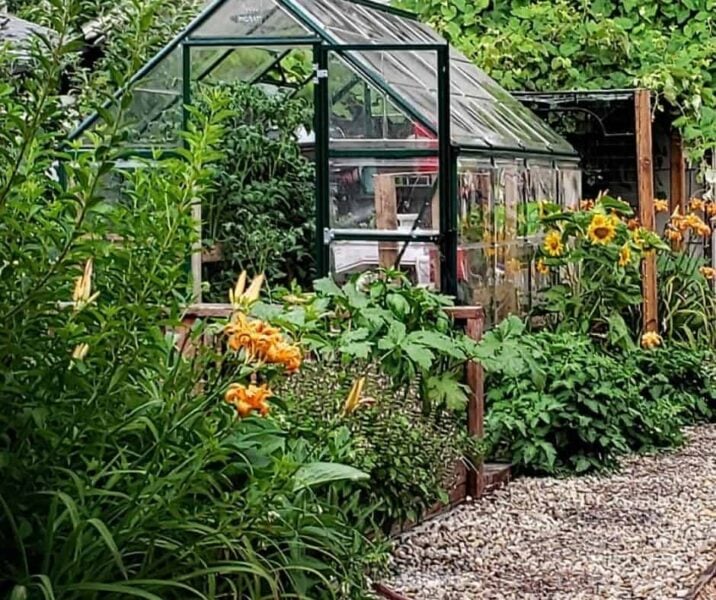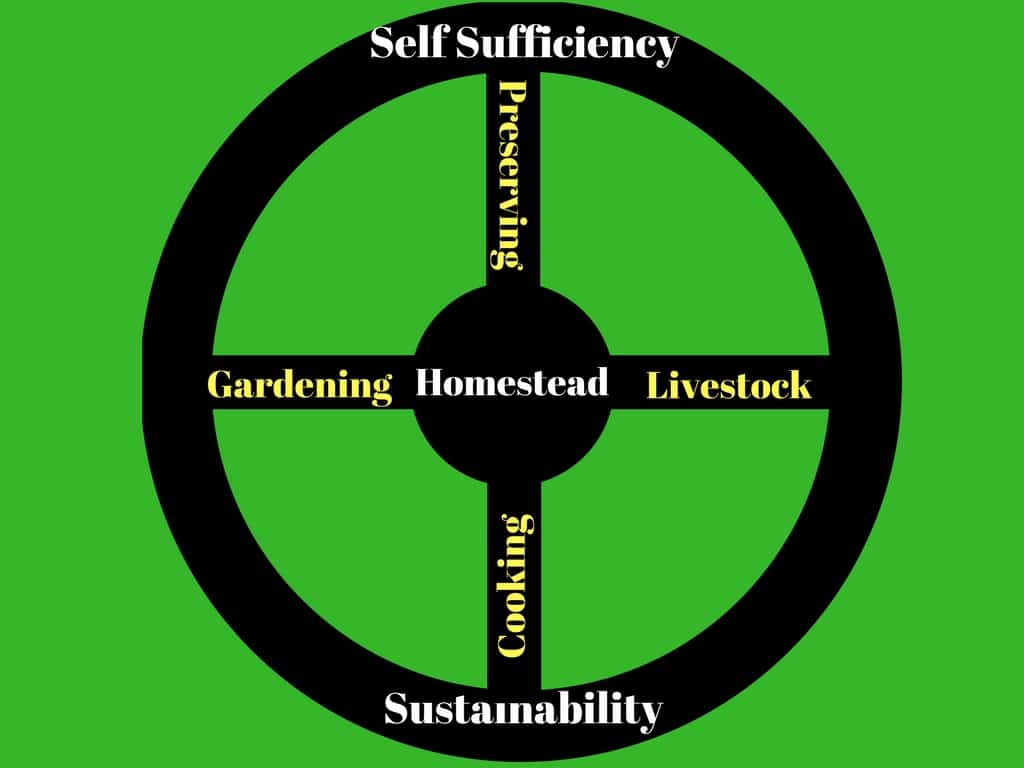When we talk about homesteading in today’s context, we generally mean it very differently than the word has been traditionally used. In today’s context, it might be better to identify the term as modern homesteading.

Modern Homesteading is the pursuit of self-sufficiency and sustainability by adding certain components and acquiring and applying knowledge and skills that can accomplish this at the desired level. This pursuit results in a home becoming a provision and an asset, giving more than it takes for this desired lifestyle.
I’ve compiled this definition through my own efforts in urban homesteading and by interviewing over 100 homesteaders on the Modern Homesteading Podcast. Over 5 years as the host of the podcast I heard many different descriptions of individual homesteads and they were all unique. However, I was able to find the common themes that made these homes modern homesteads.
“The greatest fine art of the future will be the making of a comfortable living from a small piece of land.”
― Abraham Lincoln
At What Point Does A Home Become A Modern Homestead?
To demonstrate when this happens, we will use the image of a wagon wheel, the hub or center of the wheel will be our home/land (our future homestead). The outer rim will represent two things that a homestead aims to accomplish, self-sufficiency and sustainability.

We notice in this first picture that we have no spokes connecting our hub (home) to the rim and what it represents. Therefore, this home/land is a taker of resources, not providing anything that would contribute to self-sufficiency and sustainability.
This represents the reality of most homes today. When we consider that homes generally are resource takers, consuming money in the form of a mortgage without providing anything other than shelter. When we look at the land, we see grass growing and perhaps some ornamental trees, shrubs, and plants; all these things take resources to maintain without providing anything useful toward self-sufficiency or sustainability.
Defining Our Limitations

A quick response might be to think that there are no limitations when it comes to what we have to do to connect our hub (homestead) to our outer rim (self-sufficiency and sustainability) with spokes (representing the actions of homesteading knowledge and skills). A responsible answer, however, will reveal that there are limitations when it comes to building our spokes.
Resources and Limitations
The area between the hub and the rim represents the resources and limitations we are dealing with when building our spokes. Three things are listed in the image above, Time, Knowledge, and Skills. These three things are what it takes to make our home a homestead, but they also represent the limitations to building our homestead.
Time
We only have so much time to work with. You’re probably working a full-time job at this point while pursuing homesteading. You probably have family commitments. You definitely have sleep and meal commitments. I point all this out to say that the 168 hours a week we all have gets eaten up pretty quickly and what we have left represents how much time we have for homesteading.
Knowledge
This is another resource it will take to turn your home into a homestead. The good thing about knowledge is that it can be gained with study and a little work. Knowledge, however, also represents a limitation because you can only gain so much at a time, so you need to choose what knowledge you will pursue first.
Skills
Yet another important requirement and limitation to understand. Skills too are acquirable like knowledge, but different people will have a maximum level of expertise they can obtain in certain things. What I mean by this is some people are just better at certain things than other people. That doesn’t mean you won’t be able to do it; it just means some people might do it better.
You can see how these three things must be considered when you begin to build your homestead. You must consider how much time you have, the knowledge you are willing to obtain, and the skills you are willing to develop to do the things you want to do on your homestead.
Making Your Home A Homestead

Adding The Garden
Let’s connect our first spoke and put our home on a path to being a homestead. We see in this illustration that by adding a garden to our home, we can add a certain amount of self-sufficiency and sustainability to our home. Adding a garden doesn’t necessarily make your home a homestead at this point, it just makes you a gardener. No wheel can function well with only one spoke, but it’s a massive step towards your goals.
I will also point out that a homestead doesn’t have to have a garden. It just has to have multiple spokes connecting it to the outer rim. It’s hard to imagine a homestead without a garden, but not impossible if you are pursuing several other areas of self-sufficiency and sustainability.
Bringing In Livestock
In the next illustration, we add a second spoke and double our connection to the outer rim and bringing a lot of stability to our wheel. This home is well on its way to becoming a homestead. The spoke I chose to add here is livestock, again not because it’s a required one but because it’s a common one.

The type of livestock is irrelevant as long as it is productive. Does it provide you with more than it takes to raise them? Does the livestock offer you a healthy meat source? Does it provide you with compost, land management, or profit? Whatever the livestock does for your homestead, it has to give more than it takes in order to make a connection to self-sufficiency and sustainability.
Food Preservation
Now we add another spoke, which provides even more connection and more stability to the wheel. I think at this point, with three connections, it’s safe to say you have turned your home into a functioning homestead. I chose to add the spoke of food preservation here because it makes the other two spokes more useful for the homestead as you will undoubtedly be looking for ways to preserve food from the garden and the meat from the livestock.

There are several areas of food preservation you could focus on, blanching and freezing, water bath and pressure canning, dehydrating, fermenting, cold smoking, etc. All these things add a more solid connection to the outer rim, and I will have more to say about these later in the book.
Cooking Skills
The next spoke I decided to add is yet another that forms an inner connection to the others. I believe the skill of cooking from scratch is one of the most valuable and most overlooked homesteading skills you can develop. I feel like it’s one of the best spokes you can add to the wheel as it creates an essential level of self-sufficiency and sustainability.

Cooking from scratch is probably the one skill I saw as the least important when I started homesteading but quickly realized I was wrong.
At this point, you get where I’m going with the wheel design. It would be best if you continued to add spokes as time, knowledge, and skills allow and continue to make your homestead as self-sufficient and sustainable as possible.

I want to break in here as I’m explaining this and say that it’s important to remember through this process of turning your home into a homestead that you don’t have to do everything, and you shouldn’t even try as this WILL lead to burnout. I have seen it too many times, and I can say with confidence that you need to add your spokes with much care and intention and not add things that aren’t necessary according to your larger plan.
Consider this quote:
“Ours is a culture where we wear our ability to get by on very little sleep as a kind of badge of honor that symbolizes work ethic, or toughness, or some other virtue–but really, it’s a total profound failure of priorities and of self-respect.”
—Maria Popova
Adding Other Components and Skills
I filled in a few more spokes here to show you some other excellent homesteading skills to focus on that I believe are some of the best ones to develop.

Composting
This being hot composting where you build a mound of carbon (browns) and nitrogen (greens) to quickly turn the material into a great amendment for your garden. Cold composting where you would simply pile up organic material and let it slowly break down to compost and vermicomposting, which is composting with worms.
Making Your Own Household Cleaners and Personal Products
Items such as deodorant, bath soap, laundry soap, non-toxic cleaners for tubs, counters, and glass, and whatever else you can make to replace harsh commercial products.
Making Your Own Herbal Remedies
starting with the safer, easier plants such as dandelion, plantain, and comfrey, and then moving on to more complex remedies. A great resource for acquiring this skill is The Herbal Medicine-Maker’s Handbook: A Home Manual.
- MEDICINE MAKER'S HANDBOOK
- Green, James (Author)
- English (Publication Language)
Last update on 2024-07-26 / Affiliate links / Images from Amazon Product Advertising API
Bushcrafting Skills
Skills like outdoor survival, hunting, fishing, and foraging. These skills can be beneficial for homestead development and providing you with another level of self-sufficiency and sustainability.
As you can see demonstrated in this final wagon wheel illustration, the time, knowledge, and skills area can be filled in with spokes of whatever you want to do. This is where you will pursue your passions that will make your homestead unique to any other.

I do want to point out that what I have demonstrated here using these illustrations does not require a certain amount of land. Of course, there are things you would be limited to with less land, but spokes from the hub to the rim can be built anywhere.
In other words, to be a modern homesteader, all you need is a home, and that can be anything from an apartment to a house on many acres.




